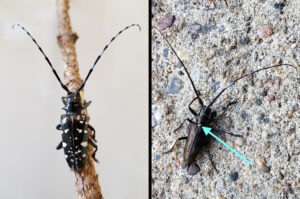
Two closeup photos show the similarities and differences between an adult Asian longhorned beetle, left, with spots all over its back and striped antennae; and an adult whitespotted sawyer beetle, right, with one white spot beneath its head and between its wings.
By Michael Hillstrom, DNR Invasive Forest Pest Coordinator
Michael.Hillstrom@wisconsin.gov
More than 300 species of longhorn beetles inhabit the Midwest. The Wisconsin Department of Natural Resources (DNR) posted about one species, the invasive Asian longhorned beetle (ALB), on social media in early July.
Forest Health staff received many photos of potential ALB as a result. Fortunately, none of the photos were of ALB – which has yet to be detected in Wisconsin.
By far, the most common insect seen in the submitted photographs was a native longhorn species called the whitespotted sawyer beetle (Monochamus scutellatus), also known as a pine sawyer beetle.
Whitespotted sawyers are often mistaken for ALB. However, ALB is a big, burly insect that makes our native sawyer beetle look slim in comparison. Additionally, ALB is very smooth and shiny, with distinct white spots on black wing covers. Our native sawyer beetle appears pitted or dusty, and the white spots may be less distinct or absent.
Finally, our native beetle has a nice white dot between its “shoulders,” where the wing covers meet, and ALB does not.
This time of year, you may see these whitespotted sawyer beetles slowly flying around, especially in areas with pine trees. Their larvae develop in weakened, recently dead or recently harvested conifers for one to two years. On a summer day, you can hear the larvae loudly chewing under the bark of infested trees. They pupate within the tree, and adults chew their way out, leaving large, round exit holes. Adults feed on needles and twig bark, which can cause fine branch mortality.
Areas with storm-damaged pine, conifer decline and stressed conifers attract these beetles. Research has found that whitespotted sawyers are an ecologically important species, because they help speed up nutrient cycling by breaking down the wood of trees that are already in decline.
